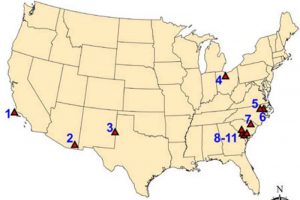
He also says the platinum anomaly is similar to the well-documented finding of iridium, another element associated with cosmic objects, that scientists have found in the rock layers dated 65 million years ago from an impact that caused dinosaur extinction. That event is commonly known as Cretaceous-Tertiary or K-Pg by scientists.
“In both cases, the anomalies represent the atmospheric fallout of rare elements resulting from an extraterrestrial impact,” Moore says.
He says the K-Pg dinosaur extinction was the result of a very large asteroid impact while the Younger-Dryas onset impact is likely the result of being hit by fragments of a much smaller sized comet or asteroid, possibly measuring up to two-thirds a mile in diameter.
“Another difference is that the Younger-Dryas impact event is not yet associated with any known impact crater,” Moore says. “This may be because the fragments of the large object struck the glacial ice-sheet or exploded in the atmosphere. Several candidate craters are under investigation but have not been confirmed.”
Moore says while his team’s data does not contradict the Young-Dryas impact hypothesis, it also does not explain the likely effects that such an impact could have had on the environment, Paleoindians or ice-age animals.
Contributing to the study is Moore’s university colleagues Mark Brooks, a geo-archaeologist who conducts research and excavations at the Savannah River Site, and archaeologist Albert Goodyear, who has spent decades documenting Clovis culture at the famed Topper site. Topper, located in Allendale County, South Carolina, along the banks of the Savannah River, is considered one of the most pristine U.S. sites for research on Clovis, one of the earliest ancient people.
Goodyear’s work with Moore builds on research in which he found traces of extraterrestrial elements, including iridium, at the Younger-Dryas layer at Topper that was published in the Proceedings of the National Academy of Sciences in 2012.
Moore, Goodyear and Brooks conduct research through the South Carolina Institute of Anthropology and Archaeology in the university’s College of Arts and Sciences.[xyz-ihs snippet=”Adsense-responsive”]In addition to Topper, the remaining 10 archaeological sites that Moore, Goodyear and others on their team conducted research in 2016 included Arlington Canyon on Santa Rosa Island, California; Murray Springs, Arizona; Blackwater Draw, New Mexico; Sheriden Cave, Ohio; Squires Ridge and Barber Creek, North Carolina; and Kolb, Flamingo Bay, John Bay and Pen Point, South Carolina.
Moore says the bottom line of the study and paper in the journal Scientific Reports is the presence of an easily identifiable hemispheric marker (platinum) in sediment layers for the start of Younger-Dryas. That discovery contributes to the body of evidence that a potential cosmic impact event occurred and warrants further scientific investigation.
Source: University of South carolina
Pages: 1 2
